#commercial estimator queens
Explore tagged Tumblr posts
Text
Overhaul Your Area: 10 House Renovation Ideas to Transform Your Living Environment
""
Are you tired of living in a room that really feels outdated or lacks performance? It's time to take issues right into your own hands and also start a house renovation trip. From little adjustments to significant improvements, there are countless means to revamp your space as well as develop a home that absolutely mirrors your style and boosts your everyday life. In this post, we will certainly discover 10 residence renovation ideas that will transform your living setting and also make you fall for your home throughout again.Paragraph 2: Firstly,
let's begin with the heart of every home -the kitchen. Think about upgrading your cooking area closets, kitchen counters, as well as appliances to develop a fresh and also modern-day look. Installing brand-new floor covering can also make a significant difference in the overall aesthetic. Next, focus on your washrooms by changing outdated fixtures, including new lighting, as well as upgrading the floor tiles. These easy modifications can raise the look as well as feel of these spaces quickly. Additionally, do not ignore your living-room. A fresh layer of paint, brand-new furniture items, and elegant decoration can completely change the setting of the room, creating a comfy as well as welcoming environment. Ultimately, take into consideration including or remodeling exterior home, such as a patio or deck, to prolong your living location and also create a sanctuary for leisure and also amusement. By implementing these house improvement ideas, you can rejuvenate your living setting as well as turn your house into a desire home.
Read more here Learn More
0 notes
Text
Transform Your Living Area with These Basic Residence Renovation Tips
""
Residence enhancement is a terrific method to include worth to your residential or commercial property as well as create a more comfortable living room. Whether you are wanting to make little updates or take on a significant remodelling job, there are lots of basic means to change your house. One of the most convenient and most affordable methods to improve your residence is to take on little do it yourself tasks, such as painting walls, mounting brand-new lights, or upgrading your hardware. These simple changes can make a huge difference in the look and also feel of your home.Another wonderful
way to enhance your home is to concentrate on energy performance. By making upgrades such as adding insulation, changing home windows, or mounting a programmable thermostat, you can save cash on your power bills and also produce a more comfortable living room. In addition, purchasing outside renovations such as landscaping or a brand-new deck can assist you make the many of your outdoor living space and also increase the overall value of your building. Whether you are seeking to offer your home or merely desire to produce an extra comfy living room, home enhancement is an excellent method to achieve your objectives.
Read more here drexelestimatingllc.com
0 notes
Text
Change Your Living Area with These Straightforward House Renovation Tips
""
Residence renovation is a terrific way to add worth to your residential or commercial property and develop a much more comfy living room. Whether you are seeking to make little updates or embark on a major remodelling task, there are a lot of basic means to transform your house. Among the simplest and also most economical means to boost your residence is to deal with little DIY tasks, such as repainting walls, mounting brand-new light fixtures, or updating your hardware. These basic changes can make a large distinction in the appearance as well as feeling of your home.Another terrific
method to boost your home is to concentrate on power efficiency. By making upgrades such as including insulation, replacing windows, or mounting a programmable thermostat, you can save cash on your energy bills and develop an extra comfortable living room. Additionally, buying outdoor improvements such as landscaping or a brand-new deck can aid you make the most of your outside living area and increase the total worth of your property. Whether you are aiming to sell your residence or just wish to create an extra comfy living space, home enhancement is an excellent means to achieve your objectives.
Read more here Learn More
0 notes
Text

One Giant Leap for Mankind
Millions of people around the globe will come together for the Paris 2024 Olympic Games later this month to witness a grand event—the culmination of years of training and preparation.
Fifty-five years ago this July, the world was watching as a different history-changing event was unfolding: the Apollo 11 mission was landing humans on the surface of another world for the first time. An estimated 650 million people watched on TV as Neil Armstrong reached the bottom of the ladder of the lunar module on July 20, 1969, and spoke the words, “That’s one small step for [a] man, one giant leap for mankind.”
While the quest to land astronauts on the Moon was born from the space race with the Soviet Union during the Cold War, this moment was an achievement for the whole of humanity. To mark the world-embracing nature of the Moon landing, several tokens of world peace were left on the Moon during the astronauts’ moonwalk.

“We came in peace for all mankind”
These words, as well as drawings of Earth’s western and eastern hemispheres, are etched on a metal plaque affixed to a leg of the Apollo 11 lunar lander. Because the base of the lander remained on the Moon after the astronauts returned, it is still there today as a permanent memorial of the historic landing.

Microscopic messages from kings, queens, and presidents
Another artifact left on the Moon by the Apollo 11 astronauts is a small silicon disc etched with goodwill messages from leaders of 74 countries around the world. Each message was reduced to be smaller than the head of a pin and micro-etched on a disc roughly 1.5 inches (3.8 cm) in diameter. Thailand’s message, translated into English, reads: "The Thai people rejoice in and support this historic achievement of Earth men, as a step towards Universal peace."
Curious to read what else was inscribed on the disk? Read the messages.

An ancient symbol
The olive branch, a symbol of peace and conciliation in ancient Greek mythology, also found its way to the Moon in July 1969. This small olive branch made of gold was left on the lunar surface during Neil Armstrong and Buzz Aldrin’s 2.5-hour moonwalk. The olive branch also featured on the Apollo 11 mission patches sewed on the crew’s spacesuits. Designed in part by command module pilot Michael Collins, the insignia shows a bald eagle landing on the Moon holding an olive branch in its talons.

We go together
As NASA’s Artemis program prepares to again land astronauts on the Moon, including the first woman and the first person of color, this time we’re collaborating with commercial and international partners. Together we will make new scientific discoveries, establish the first long-term presence on the Moon, and inspire a new generation of explorers.
Is aerospace history your cup of tea? Be sure to check out more from NASA’s past at www.nasa.gov/history.
Make sure to follow us on Tumblr for your regular dose of space!
4K notes
·
View notes
Text
Socialism: Utopian and Scientific - Part 21
[ First | Prev | Table of Contents | Next ]
In spite of all this, Owen was not content. The existence which he secured for his workers was, in his eyes, still far from being worthy of human beings. "The people were slaves at my mercy." The relatively favorable conditions in which he had placed them were still far from allowing a rational development of the character and of the intellect in all directions, much less of the free exercise of all their faculties.
“And yet, the working part of this population of 2,500 persons was daily producing as much real wealth for society as, less than half a century before, it would have required the working part of a population of 600,000 to create. I asked myself, what became of the difference between the wealth consumed by 2,500 persons and that which would have been consumed by 600,000?” [3]
The answer was clear. It had been used to pay the proprietors of the establishment 5 per cent on the capital they had laid out, in addition to over £300,000 clear profit. And that which held for New Lanark held to a still greater extent for all the factories in England.
“If this new wealth had not been created by machinery, imperfectly as it has been applied, the wars of Europe, in opposition to Napoleon, and to support the aristocratic principles of society, could not have been maintained. And yet this new power was the creation of the working-classes.”
To them, therefore, the fruits of this new power belonged. The newly- created gigantic productive forces, hitherto used only to enrich individuals and to enslave the masses, offered to Owen the foundations for a reconstruction of society; they were destined, as the common property of all, to be worked for the common good of all.
Owen’s communism was based upon this purely business foundation, the outcome, so to say, of commercial calculation. Throughout, it maintained this practical character. Thus, in 1823, Owen proposed the relief of the distress in Ireland by Communist colonies, and drew up complete estimates of costs of founding them, yearly expenditure, and probable revenue. And in his definite plan for the future, the technical working out of details is managed with such practical knowledge – ground plan, front and side and bird’s-eye views all included – that the Owen method of social reform once accepted, there is from the practical point of view little to be said against the actual arrangement of details.
His advance in the direction of Communism was the turning-point in Owen’s life. As long as he was simply a philanthropist, he was rewarded with nothing but wealth, applause, honor, and glory. He was the most popular man in Europe. Not only men of his own class, but statesmen and princes listened to him approvingly. But when he came out with his Communist theories that was quite another thing. Three great obstacles seemed to him especially to block the path to social reform: private property, religion, the present form of marriage.
[3] From The Revolution in Mind and Practice, p.21, a memorial addressed to all the ��red Republicans, Communists and Socialists of Europe,” and sent to the provisional government of France, 1848, and also “to Queen Victoria and her responsible advisers.”
[ First | Prev | Table of Contents | Next ]
22 notes
·
View notes
Text
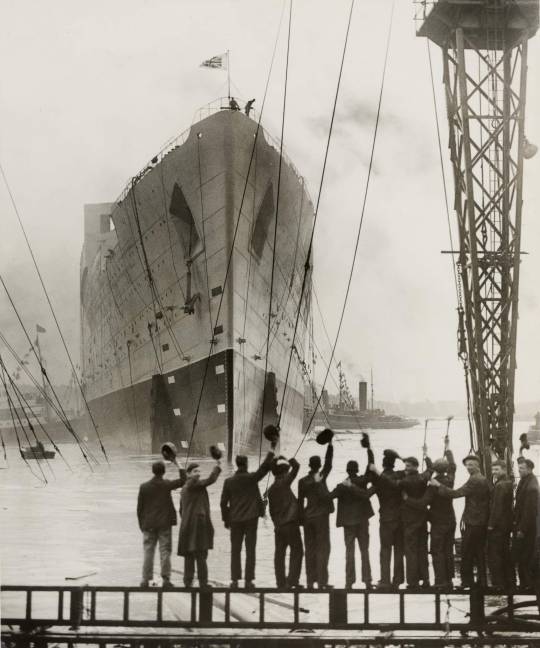
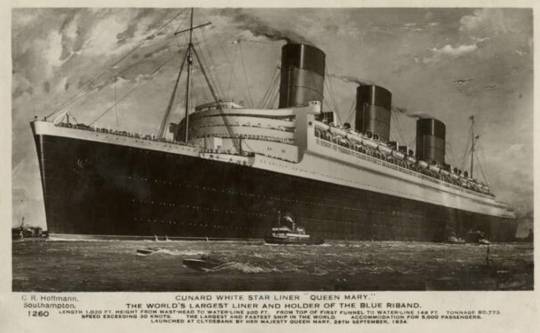
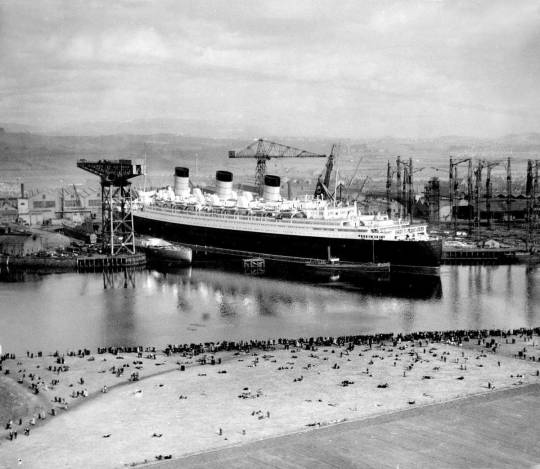
On September 26th 1934 the Liner Queen Mary launched at John Brown’s shipyard, Clydebank.
The construction of still the unnamed Cunard Queen Mary ship began in December 1930 (the ship’s keel was laid down on 31 January 1931) in the yard of “John Brown & Co” at Clydebank. The launch was scheduled for May 1932, but the work on the ship was suspended in December 1931 due to the world economic depression. A loan of 9.5 million pounds from the Government was granted to the Cunard Line with enough money to complete the Queen Mary ship and to build a second liner – the Queen Elizabeth.
As a direct result of this most advantageous deal, the Cunard Line merged with its main rival White Star on 10th May 1934 into Cunard White Star Ltd. The Queen Mary construction resumed in April 1934, the liner was completed by August and launched on 26th September at a total cost of 3.5 million pounds sterling.
The work was completed in March 1936. The Queen Mary ship sailed out for preliminary trials and after being painted in Southampton, the liner was handed over to Cunard White Star Line on 11th May 1936. RMS Queen Mary ship first sailing was on 14th May with its Transatlantic itinerary being Southampton-Cherbourg-New York. By May 1937 the liner had carried a total of almost 57,000 passengers.
The main speed-rival of the QM ship was SS Normandie – a liner built in France and operated by the French Compagnie Generale Transatlantique line. The Queen Mary took the Blue Riband (the prestigious award given to a ship with the speed record for a transatlantic crossing) from the French liner SS Normandie in August 1938, with record speeds for both west- and eastbound crossings of the Atlantic Ocean – the average speeds was, respectively, 30,63 kn (35m25 mph, 56,7 km/h) and 30,14 kn (34,68 mph, 55,82 km/h).
In 1937, the Normandie liner was refitted with new propellers, enabling her to take the Blue Riband, but in 1938 the Queen Mary ship reclaim the honour for best speeds in both directions – westbound 30,99 kn (35,66 mph, 57.39 km/h) and eastbound 31,69 kn (36,47 mph, 58.69 km/h). This record was beaten by the SS United Sates liner in 1952.
The last commercial sailing of the ship Queen Mary was on 30 August 1939 departing from Southampton and then berthed at New York until the end of 1939. With the outbreak of the Second World War, she was converted into a troopship and ferried Allied soldiers for the duration of the war.
Following the war, Queen Mary was refitted for passenger service and along with Queen Elizabeth commenced the two-ship transatlantic passenger service for which the two ships were initially built. The two ships dominated the transatlantic passenger transportation market until the dawn of the jet age in the late 1950s. By the mid-1960s, Queen Mary was ageing and, though still among the most popular transatlantic liners, was operating at a loss.
After several years of decreased profits for Cunard Line, Queen Mary was officially retired from service in 1967. She left Southampton for the last time on 31 October 1967 and sailed to the port of Long Beach, California, United States, where she remains permanently moored. Much of the machinery, including one of the two engine rooms, three of the four propellers, and all of the boilers, were removed. The ship serves as a tourist attraction featuring restaurants, a museum and a hotel. The ship is listed on the National Register of Historic Places. The National Trust for Historic Preservation has accepted the Queen Mary as part of the Historic Hotels of America.
RMS Queen Mary remains in Long Beach but recently it has been reported it is in need of significant repairs according to assessments and photos in 2019 and 2020. An estimated $289 million in repairs are needed after years of decline and the most recent operator going bankrupt.But even to “retire and recycle” the liner could cost up to $190m. One of the suggestions are to dismantle and sink the liner, although no long term plans have been finalised as yet.
The Queen Mary is due to open again to visitors next month, let’s hope someone can come up with a rescue plan to save her.
It has been mooted that it could return to the Clyde but the eyewatering amount of money it would take surely rules this out.
23 notes
·
View notes
Note
For more than 4,000 years, emeralds have been among the most valuable of all jewels.
Colombia, located in northern South America, is the country that mines and produces the most emeralds for the global market, as well as the most desirable.
It is estimated that Colombia accounts for 70–90% of the world's emerald market. While commercial grade emeralds are quite plentiful, fine and extra fine quality emeralds are extremely rare. Colombian emeralds over 50 carat can cost much more than diamonds of the same size.
The Colombian departments of Boyacá and Cundinamarca, both in the Eastern Ranges of the Colombian Andes, are the locations where most of the emerald mining takes place.
Although the Colombian emerald trade has a rich history that dates as far back as the pre-Columbian era, the increase in worldwide demand for the industry of the gemstones in the early 20th century has led prices for emeralds to nearly double on the global market.
Until 2016, the Colombian emerald trade was at the center of Colombia's civil conflict, which has plagued the country since the 1950s.
For thousands of years, emeralds have been mined and considered one of the world's most valuable jewels.
The first ever recorded emeralds date back to ancient Egypt, where they were particularly admired by Queen Cleopatra.
In addition to their aesthetic value, emeralds were highly valued in ancient times because they were believed to increase intelligence, protect marriages, ease childbirth, and thought to enable its possessor the power of predicting future events.
An ancient Colombian legend exists of two immortal human beings, a man and a woman—named Fura and Tena—created by the Muisca god Are in order to populate the earth.
The only stipulation by Are was that these two human beings had to remain faithful to each other in order to retain their eternal youth. Fura, the woman, however, did not remain faithful.
As a consequence, their immortality was taken away from them. Both soon aged rapidly, and they eventually died. Are later took pity on the unfortunate beings and turned them into two crags protected from storms and serpents and in whose depths Fura's tears became emeralds.
Today, the Fura and Tena peaks, rising approximately 840 and 500 meters, respectively, above the valley of the Minero River, are the official guardians of Colombia's emerald zone. They are located roughly 30 km north of the mines of Muzo, the location of the largest emerald mines in Colombia.
Historians believe the indigenous people of Colombia mastered the art of mining as early as 500 AD. But Spanish Conquistadors are the ones who are credited with discovering and marketing globally what we now call Colombian emeralds.
Colombia, during pre-colonial times, was occupied by Muzo indigenous people, who were overpowered by Spain in the mid-1500s. It took Spain five decades to overpower the tribal Muzo people who occupied this entire mining area.
Once in control, the Spanish forced this native, indigenous population to work the mining fields that it previously held for many centuries.
Monarchs and the gem-loving royalty in India, Turkey, and Persia eventually sought the New World treasures once the gems arrived in Europe.
These new emerald owners expanded their private collections with spectacular artifacts bedazzled with emeralds between 1600 and 1820, the time frame of Spain's control over the Colombian mines.
After Colombia's independence from Spain in 1819, the new government and other private mining companies assumed mining operations. Over the course of the nineteenth and twentieth centuries, these mines were periodically shut down numerous times because of political situations within the country.
Colombian emeralds are much sought after, and not just because of their superb quality and color. A gem's value depends upon its size, purity, color and brilliance. Even when they are mined in the same area, each individual emerald has its own unique look that sets it apart from the rest.
Dark green is considered to be the most beautiful, scarce, and valuable color for emeralds. An emerald of this color is considered rare and is only found in the deepest mines of Colombia.
The eastern portion of the Andes, between the Boyacá and Cundinamarca departments, is where most Colombian emeralds are mined.
The three major mines in Colombia are Muzo, Coscuez, and Chivor. Muzo and Coscuez are on long-term leases from the government to two Colombian companies, while Chivor is a privately owned mine. Muzo remains the most important emerald mine in the world to this date.
The terms Muzo and Chivor do not always refer to the particular mines that carry the same name. Instead, the two terms, originating from the local indigenous language, often describe the quality and color of emeralds. Muzo refers to a warm, grassy-green emerald, with hints of yellow. Chivor, on the other hand, describes a deeper green color.
Thank you for this great reference material! Colombian emeralds are absolutely world renowned. But, when it comes to wearing the fuck out of emeralds no one can out do the Ambanis. This necklace alone is rumored to be worth $60 million USD 😮💨

21 notes
·
View notes
Text




The Economic Power of Land
Class-struggle anarchists focus their activities on the conflict between the working class and the bosses. Nowadays the usual image of the ruling class is as industrialists and financiers; the land-owning aristocracy are not considered to be the main source of capitalist power. Our analysis firmly describes landowners as an integral part of the ruling class, both in the sense of holding real economic power and in the ideological role they play in keeping the working class in their place. The land-owning class and their lackeys are a fundamental part of the British ruling class and are immensely powerful and well organised. We ignore them at our peril.
Despite propaganda about impoverished aristos and the supposed increase in land ownership by the government and the National Trust, around 80% of Britain’s land is in private hands. A hard core of titled families own almost one-third of Britain, with 60%-70% of these owning at least 5,000 acres. The Crown’s holdings are enormous: 335,000 acres of farmland, 38,285 acres of commercial forest, the entire shoreline, half the foreshore! The Queen’s private holdings are separate from this and include 50,000 at Balmoral, 20,000 acres at Sandringham and 50,000 acres of Lancaster. The Duke of Buccleuch owns 277,000 acres of Scotland and 11,000 acres of Northamptonshire. Despite the image of the struggling farmer promoted by the Countryside Alliance, the average farm size is 170 acres, much higher than the average in the rest of the EC. And consolidation of farm holdings is increasing: when a farm is sold it is other farmers that buy it. Owning land may not appear to confer economic power and wealth in an economy dominated by industry and commerce. Many landowners like to give the impression that it is a great burden. Looked at more carefully, land ownership brings enormous benefits. The value of the land itself is the first source of wealth. Since the Development Land Tax was abolished in 1985, increases in the value of land for development are subject only to a capital gains tax. Other ways of making money from the land include leasing it out to farmers, hunting and fishing rights and mining. For example, the Duke of Derbyshire receives an estimated £1.8 million in royalties every year for the mining of Derbyshire limestone. Though landowners are associated with the countryside, they also own much of urban Britain. The most well-known is the Duke of Westminster who owns a large chunk of central London including Mayfair and Belgravia. Agriculture and forestry bring the greatest benefits, chiefly in the form of subsidies. Farmers are exempt from rates on agricultural land and buildings and are also exempt from paying VAT. It is estimated that the combined benefit from all subsidies comes to £20-£30,000 per year per farmer. Forestry is another good source of income (and handouts). There has been a great increase in forestation in recent years, of which 80% is in the private sector. But while planting conifers offers a quick return its causes many ecological problems.
#anarcho-communism#anarcho-primitivism#anti-capitalism#capitalism#class#class struggle#climate crisis#colonialism#deep ecology#ecology#global warming#green#Green anarchism#imperialism#industrialization#industrial revolution#industrial society#industry#mutual aid#overpopulation#poverty#social ecology#anarchism#anarchy#anarchist society#practical anarchy#practical anarchism#resistance#autonomy#revolution
3 notes
·
View notes
Text
Taxes, Tax, Taxes- Chapter 9
Fandom: Supergirl
Characters: Kara Danvers, Clark Kent, Samantha Arias, Lena Luthor, Lillian Luthor, Ruby Arias, Oliver Queen, John Stewart, Diana Prince, Bruce Wayne, Barry Allen, J'onn J'onnz, Alfred Pennyworth, Lois Lane, Cat Grant
Summary: What if superheroes had to pay a property damage tax every time they had a fight in the city?
Chapter 1, Chapter 2, Chapter 3, Chapter 4, Chapter 5, Chapter 6, Chapter 7, Chapter 8
Lena stared at her computer screen baffled. She knew that the commercial she put out would gain attention, especially with the amount of money put towards it. However, she didn’t expect anything like this. She felt Kara and Sam’s eyes on her waiting for her response. They all agreed to gather four days after the commercial was released and go over the report the social media and marketing analysts had about the commercial.
Lena turned to Sam hesitantly and asked, “Are you seeing what I’m seeing?”
Sam let out a low whistle and said, “Yeah, I knew it would be high, but not this high.”
Kara smirked and said, “I remember saying it would go this way. You two need to pay up.”
Lena looked up at Kara. She was all bright-eyed and smiling. She found that Kara’s smile conflicted with that smugness of hers, but she definitely earned it. No one could have predicted this outcome not even the production team behind the commercial. Lena sighed and rolled her eyes. She went into her purse, took out $500, and handed it to Kara.
“A bet is a bet,” muttered Lena.
Sam went into her purse and grabbed a $20 which Lena balked at.
“I thought you betted more,” said Lena shocked and feeling a little bit betrayed.
“Supergirl made a passionate speech at the end about the commercial doing well that it made me waver in my decision,” said Sam as she handed the $20 to Kara.
Kara chuckled and said, “I don’t get why you guys are so surprised. You have a video centered around two powerful women in their own respective fields helping sick children in a hospital. Why wouldn’t the video go viral?” The only way it would have been more successful is if we added cats to it.”
Sam quickly took out her notebook, started jotting down notes, and said, “Actually, that is not a bad idea.”
Lena sighed and said, “Don’t encourage her.”
Sam gave Lena a deadpan stare and said, “We need to milk this publicity for all its worth. Plus, kittens are instantly viral. Why not?”
Lena shook her head. She wasn’t sure about the cat part, but Sam was right. The commercial took off in a bigger way than she had imagined. They originally started with the video to get an idea to see what people’s perception of Lena would be. Her marketing team initially suggested waiting two weeks to see how the video does with viewers. While they felt that Supergirl may be a draw, they were worried that Lena’s name still may be a distraction. They were cautiously optimistic that the video could get 100,000 views. Everyone did except Kara. She thought that they were all crazy for not being extremely excited about the venture and thinking that it wouldn’t spread like wildfire. She estimated that the video would have over 200 million views after two days and insisted that they met sooner to strategize their next moves. Lena initially humored her thoughts and agreed to meet four days after the video’s release to discuss the video’s prospects. But as she sat at the desk looking at the numbers, she wished she didn’t doubt the super as much.
Lena shook her head, turned to Kara, and said, “The video far exceeded your expectations. It is currently at 750 million views after four days.”
Kara smirked and said, “I told you that people would like SuperCorp.”
Lena muttered, “I still can’t believe that word is trending.”
“You have that reporter from Catco to thank about that. She has been promoting you two heavily on the company’s blog the last two days,” mused Sam.
“You mean Kara Danvers?” asked Lena.
“Yeah, that is the one,” said Sam.
“I am kind of surprised that she promoted that so heavily. Didn’t she win a Pulitzer last year for her expose on the drug rings in National City?” asked Lena.
Kara shuffled nervously from side to side and said, “Maybe, she really believes in the work that we are trying to accomplish.”
Lena stared at the super warily. She always had a confident demeanor, but now she looks almost timid.
Before Lena could say anything, Sam said, “That may be it, but regardless, we should capitalize on this viral sensation before it runs cold. I already ordered a bunch of team SuperCorp shirts with the first logo that Supergirl designed. Those should be ready in two days.”
“You did what!” exclaimed Lena.
“I know that it is a little excessive, but people are already making their own SuperCorp shirts online and selling them on Red Bubble. Also, don’t be mad, but I also had shirts made with the phrases Hold Me Like That, I Want To Be The Girl With The Red Dress, Hot Kryptonian Coming Through, and Supercorp is Couple Goals.”
Lena started rubbing her head and asked, “I’m afraid to ask, but why those in particular?”
Sam smirked and said, “The most viewed parts of the video were when Supergirl held you close at the beginning of the dance, when Supergirl dipped you at the end of the dance, and when Supergirl came out of the pool wearing her bikini. Those three clips are also trending online with those phrases as well.”
“This video is supposed to be bringing awareness to children and to the facility,” muttered Lena.”
Kara came and patted Lena on the shoulder which caused her to blush. She looked up at the super who looked down at her smiling genuinely.
“Before this video came out, there were only articles and videos on the potential dangers that the hospital could cause to the community. There were tons of conspiracy theories about the hospital being a front to abduct children and experiment on them. Now, the video is swaying people’s perspectives. I have read a ton of articles over the last four days that not only humanized you but made people want to actually visit the hospital and make their own opinions about the place,” said Kara.
Read the rest on AO3
#dc comics#dc universe#supergirl#kara danvers#lena luthor#supercorp#kara danvers x lena luthor#clark kent#superman#samantha arias#dc comics fanfiction#dccomics fanfic#supergirl fanfiction#supergirl fanfic#supergirl au#supercorp fanfiction#supercorp fanfic#fanficiton#fanfic#superheroes#lillian luthor#bruce wayne#oliver queen#diana prince#john stewart#barry allen#j'onn j'onzz#lois lane#alfred pennyworth#Ruby Arias
17 notes
·
View notes
Text
Here Are 17 Uncommon Curiosities Reportedly Found In The Ohio River
The Queen City, as Henry Wadsworth Longfellow famously wrote, sits “in her garlands dressed, on the banks of the Beautiful River.” Once claimed by the French and named by them exactly that: La Belle Riviere, the Ohio has been the soul and foundation of our city ever since the first houses went up, but our Beautiful River has also proved to be a weird and moody companion, coughing up a bizarre miscellany from time to time.
Alligators In 1879, Dr. A. Jackson Howe procured a live, three-foot long alligator for display at the museum of the Cincinnati Society of Natural History. The reptile had been captured on the Covington shore, while several others were spotted frolicking in the Ohio River among some empty coal barges. Three years later, John Thornton found an alligator sleeping beneath the floorboards of his Newport icehouse. Charles Pitts of Covington lassoed a three-and-a-half-foot alligator from the Ohio River at the foot of Covington’s Main Street in 1870.
Bodies, Lots Of Bodies Almost from the time Cincinnati was first settled bodies have been recovered from the Ohio River including suicides, victims of foul play and accidental drownings. Among the earliest casualties was Francis Kennedy, who operated the first ferry between Cincinnati and Northern Kentucky and who drowned while hauling beef cattle to Fort Washington. Over the years, the old newspapers printed hundreds of inquest reports, often directed toward ascertaining the identities of bodies found overnight.
Catfish Of Unusual Size The Cincinnati Commercial Tribune of 3 February 1849 reports that Frederick Diserens, proprietor of the William Tell restaurant, and Colonel Josiah J. Stratton of the Fire Department, had shipped a “mammoth cat fish” to the Exchange Hotel in Philadelphia. The leviathan, caught in the Ohio River at Cincinnati, measured five feet, ten inches in length and tipped the scales at 158 pounds. Prior to its shipment east, the beast hung outside Diserens’ establishment on the south side of what is now Government Square. In 2009, two fishermen landed a blue catfish measuring four feet, six inches long and weighing 96 pounds within view of downtown Cincinnati.
Chemical “Slug” The Ohio River, lined with heavily fertilized farmland and a multitude of manufacturing plants, is regularly listed as among the most polluted streams in America. Residents of a certain age will recall the great carbon tetrachloride “slug” of 1977. When a tank full of toxic “carbon tet” ruptured at the FMC Corporation facility in February of that year, it released 5000 to 6000 pounds into the Ohio River as a 50- to 60-mile “slug” of highly polluted liquid. Water purification systems up and down the river shut off intake valves until the “slug” passed.

Elephant Bathing All of Cincinnati – and Covington, too – turned out on the morning of 9 August 1860 to watch an elephant swim across the Ohio River. The elephant was Lalla Rookh, star of the Dan Rice Circus. Lalla Rookh had been, for the past decade, a highlight of Dan Rice's big-top extravaganzas. Billed as the “Pachyderm Princess,” she was famous for her tightrope act and she also danced, rang bells and fired a pistol. She was a huge draw and, according to the Cincinnati Enquirer, brought out a good crowd for her river bath, estimated between 15,000 and 20,000
Ghosts No one ever solved the 1890 murder of Billy Fee, who was knifed and shot on the banks of the Ohio River near Lawrenceburg. Almost a year later a young man traveling by boat up the river past the murder scene cried out that he could see shadows on the darkened waters vividly recreating the murder scene. For years, residents of Lawrenceburg venturing near the river at night reported visions of the dreadful crime, accompanied by the sounds of shrieks and gunshots.
Giant Snakes On 11 August 1849, a Clermont County “man of respectability” named John Wait swore to an affidavit in which he claimed to have seen a snake more than 30 feet in length on the banks of Hartman’s mill pond. A posse was assembled and searched all over for the beast with no results, even after draining the mill pond. Sightings, however, continued for the next decade. In 1858, the Cincinnati Commercial Tribune reported that the dam at Hartman’s mill had been badly damaged by a flood and the snake was assumed to have escaped toward the Ohio River. According to a 1940 article in the Cincinnati Post, the Cincinnati Zoo offered to help citizens near Gallipolis locate a snake estimated at 35 feet in length. Coincidence?
Green Clawed Beast It was a sultry afternoon on 14 August 1955 when Naomi Johnson and some friends headed to the Ohio River at Evansville for a refreshing dip. While swimming just 15 feet offshore, something swam up behind Mrs. Johnson and grabbed her leg. She felt claws scratch her leg as the thing pulled her under the water. She began kicking her assailant and was pulled under a second time before her friends lifted her out of the river. Her left leg was extensively lacerated and bruised, with one mark distinctly hand-shaped. Mrs. Johnson claimed to have seen a UFO just before she was attacked, and there were several UFO sightings in the Evansville area around the time of the incident, leading her to believe an extraterrestrial origin for her attacker.
Kentucky Border For most of our region’s history, the entire Ohio River belonged exclusively to Kentucky. That all changed on 21 January 1980, when the United States Supreme Court fixed the border between Ohio and Kentucky at the low-water mark of the river in 1792. With two centuries of dam construction and other navigational improvements, the Ohio River is significantly deeper and wider than it was in the 1790s. The border is now, in some cases, hundreds of feet off the Ohio shore.
Madonna’s Yacht Rusting away in an Ohio River tributary just 25 miles downriver from Cincinnati is a 186-foot yacht originally known as the Celt but probably most famous as the USS Sachem among a variety of names acquired over its 120-year history. Thomas Edison used it for anti-submarine research. It ran out of New York as a recreational fishing vessel and served as a coastal patrol ship during World War II. After the war it hauled tourists around Manhattan. Robert Miller of Finneytown bought the yacht for $7500 in the 1980s and rented it out to Madonna, who filmed part of her “Papa Don’t Preach” video onboard. Miller hauled it upriver to its current resting place shortly after sailing a boatload of friends around the rededication of the Statue of Liberty in 1986.
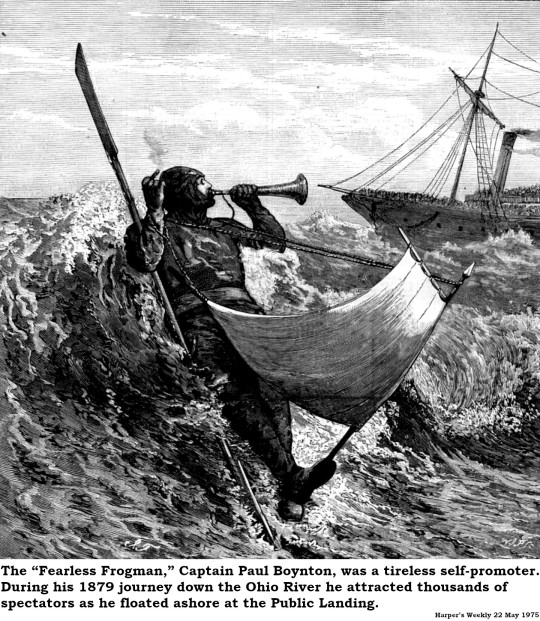
Man Afloat On 11 March 1879, a crowd of fifteen thousand swarmed the riverfront to catch a glimpse of the “Fearless Frogman,” Captain Paul Boynton, as he arrived in Cincinnati while floating from Pittsburgh to Cairo in a buoyant rubber suit. Outfitted with sails and oars, Boynton’s “peculiar life-saving dress” allowed him to maintain speeds of five or six miles per hour on his downriver odyssey. That night, he attended a performance at the Grand Opera House on Vine Street and, being recognized, was called to the stage and compelled to give a speech.
Mud Mermaids The Cincinnati Enquirer of 6 September 1894 reported two “nondescript creatures, horrible in appearance and strange in habits” at a sand bar in the Ohio River near Vevay, Indiana. The creatures appeared to be carnivorous, dining on fish and mussels plucked from the river. They were described as being yellowish in color, about five feet long, with webbed and clawed hands and feet. Their hairless heads had sharply pointed ears standing straight up. In the years since, the Vevay beings have been dubbed “Mud Mermaids.”
Octoman Police dispatchers along both sides of the Ohio River were swamped with frantic calls from late January to early February 1959 as dozens of residents and travelers reported strange creatures emerging from the depths. Sightings were recorded from New Richmond to the Licking River bridge. One witness compared the critter to an octopus while others said it looked like an immense human, leading to the nickname Octoman. Panic spread, with one 11-year-old boy calling the Cincinnati Post to confirm his teacher’s story that green men were clambering out of the river in platoons of twelve. To add to the mystery, all the streetlights along Kellogg Avenue from Lunken Airport to Coney Island extinguished as the first reports came in. After a week, sightings abated and Octoman seemingly disappeared.
Petroglyphs Just as the Ohio River slips across the state line from Pennsylvania, at the junction with Little Beaver Creek at East Liverpool, it covers a vast array of submerged designs carved into the rock. First recognized by French explorers in 1755, the display has been largely immersed in a much deeper river, only occasionally emerging into visibility in times of extreme drought. Hundreds of these Native American carvings were found for about 10 miles along the Ohio River from Midland, Pennsylvania through Wellsville, Ohio. The origin or date of the petroglyphs remains unknown and will likely never be determined.
Sea Lion In May 1962 several people reported a strange beast frolicking in the Ohio River near the Fernbank locks. The animal was not large; maybe three feet in length, but it was unlike anything naturally associated with the wildlife of the area. An expedition organized by the Cincinnati Zoo discovered that the mysterious visitor was a sea lion named “Playful George” that had escaped from a menagerie in Huntington, West Virginia and made its way nearly 200 miles downriver to the Markland Dam. George was captured and quarantined at the Zoo before returning home.
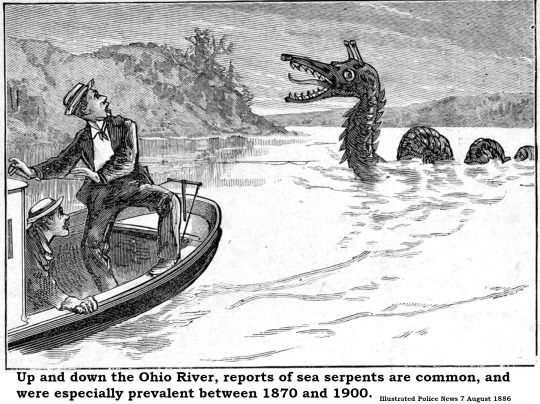
Sea Serpents In the dim, pre-dawn light of Friday, 11 January 1878, Ben Karrick was driving his horse-drawn delivery wagon over the Roebling Suspension Bridge when he saw a most unusual sight in the Ohio River below – a sea serpent. He told the Cincinnati Gazette that the creature’s serpentine head protruded from the water some twelve or fifteen feet and it lashed the water into foam with its tail. Karrick told the newspaper that the beast made a noise similar to the deep lowing of a cow, interspersed with a loud hissing noise. A day previously, John Davidson, master of the Silver Moon steamboat, saw a nearly identical monster while docked at Vevay, Indiana. In July 1893, pleasure boaters near Blennerhassett Island saw “a monstrous submarine animal or serpent, with an immense head and staring, bulbous eyes” gliding alongside their boat. The witnesses estimated the critter at more than 10 feet in length.
Underwater Pedestrian Newspapers around the nation carried the news in July 1878 that Captain John T. Guire, identified as “the celebrated submarine diver,” had entered into a wager that he would walk from Cincinnati to Cairo on the bottom of the Ohio River. Guire’s previous exploits in the Mississippi River at Saint Louis were cited as proof of his skill and determination. Although it was noted that Guire engaged in practice strolls near Cincinnati, it does not appear that the 500-mile underwater hike to Cairo ever materialized.
23 notes
·
View notes
Text

Kabukichō is the red light district in Shinjuku, a commercial and administrative ward in central Tokyo. Apparently Kabukichō took its name from plans to build a kabuki theater in the district sometime in 1940s. This never happened. Instead the area became a busy red light world of nightclubs, hostess clubs and love hotels. It’s estimated there are some 3,000 such enterprises operating in Kabukichō today. At night, the busy neon-lit streets thrive with the curious and the criminal—around a thousand yakuza are said to operate in the area. All this relentless activity gave Kabukichō its nickname as the “Sleepless Town” (眠らない街). Among the curious drawn to Kabukichō was photographer Watanabe Katsumi (1941-2006). During the 1960s and 1970s, this seemingly quiet and unassuming character prowled the streets camera in hand offering to take pictures of the sharp-suited yakuza, the pimps, the prostitutes and the drag queens who lived and worked in and among this red light district’s narrow streets. Watanabe thought of Kabukichō as his theater and the men and women who posed for him as his actors. He approached each of his subjects and offered to take their picture. He took the pictures quickly
2 notes
·
View notes
Text

Stone Creations of Long Island Pavers and Masonry specializes in masonry design and outdoor living, serving communities all across Long Island, Queens and Brooklyn in all aspects of home improvement and repair. From custom brickwork and pavers to asphalt and concrete, Stone Creations of Long Island provides free estimates at your home or business seven days a week. With experienced employees, and a knowledgeable staff, Stone Creations of Long Island knows your home is your greatest investment and choosing the right masonry team to protect and enhance that investment is important. For any inquiries, we look forward to your questions and helping on your next home improvement or commercial project of any scale. Paul Saladino Office (631) 678-6896
Visit Our Website : www.stonecreationsoflongisland.net See our work on You Tube : www.youtube.com/user/stonecreationsLI/videos Follow us on Twitter www.twitter.com/stone_creations Check us out on Pinterest www.pinterest.com/stonecreations See Our Work On Houzz www.houzz.com/pro/stonecreationsoflongisland Follow our Updates on www.stonecreationslongisland.tumblr.com Follow us on Wordpress www.stonecreationsoflongislandinc.wordpress.com Like us on Facebook www.facebook.com/stonecreationsoflongisland www.instagram.com/stonecreationsoflongislandinc
#sod#grass#installing sod#www.stonecreationsoflongisland.net#stone creations of long island#longisland#cambridge pavingstones#outdoor living#stonework#long island pools#paul saladino#poolscapes#paver patios#installing artificial grass#installing solar panels#11795#11357#111123#11779#11771#11751#swimming pools#dixhills#deerparkny11729#port jefferson#suffolkcounty#nassaucounty#paulsaladino#dana saladino#deer park driveways
3 notes
·
View notes
Note
How much does Ben get paid per role? I know roles vary but what is his average salary? And what's his most expensive role? My bet is on Paddington but I cant estimate how much...
ok real talk: i have literally no idea lol. the only thing we actually know for sure is that his birdseye adverts paid him more than £9k since they covered the cost of his RADA degree. even in the sony leaks where they discuss ben, it doesn't say anything about how much they wanna pay him, only about how homophobic he found their freddie mercury script and how much one of them wishes they'd seen him in mojo, lmao.
i think everything coming out at the moment with the hollywood strikes is showing that for every marvel blockbuster millionaire role, there are another ten thousand roles where you earn literal pennies despite being a household name. ben isn't very commercial and tends to stick to his lil art-house gay roles which have tiny budgets, so i doubt he earns much from them. like, he's obviously not on the breadline, but i doubt he's got money money.
and i agree with you it's probably paddington! bond makes a lot more money in total as a franchise but he's just a bit-part in those, whereas he's the main character and surely gets a fuckload of residuals from paddington being repeated on tv (the paddington mania after the queen died was probably the biggest pay out he's ever had, lbr).
2 notes
·
View notes
Photo

“Sault Moulds the Alien Into Good Canadian; Clubs, Lodges and Churches Help,” Sault Star. December 12, 1932. Page 3. ---- Italians Lead Numerically Those of Foreign Extraction; Finns Next ---- That the west end of the city is progressing from a social standpoint is amply demonstrated by a review of the various organizations existing in that section at the present time. Church, club and commercial enterprise have done a great deal in transforming he west end district from a sparsely settled shrub covered country of 20 years ago into the prospering, pleasant locality which it is today. With churches numbering in the neighborhood of 20, attended by residents of the west end to a great extent, clubs and lodges with an almost exclusive west end membership. numbering eight, not including those. with church connections and business establishments which compete with the average of any community, the residents of that part of the city are due to a great portion of the credit for the making of a thriving and friendly Sault Ste. Marle
Unlike the eastern part of the city, the west end is divided to a great extent into small communities, each populated by people of a certain nationlity. The new Canadians, consisting of people of Italian, Polish, Ukrainian, Fincish, Ruthenian and Croatian stock, occupy the greater part of the section generally referred to as west. Each one of these small communities has its own churches, clubs and to some extent business establishments, but despite this fact the new Canadian resident cannot be termed clannish, for at all times he is willing to mingle and enjoy himself with the crowd.
There are several institutions which have done a great work in moulding the character of the people from the old land and their children, in such a manner as to render them first class Canadians, but probably the most outstanding of these are the All Peoples' United Church, the St. Mary's School and the McFadden School. In cases where the parents were poor and terribly busy in the grind and rush of earning a livelihood in a strange land, the three named institutions are deserving of every commendation for instructions and care rendered to the children along religious, social and physical lines.
The two leading Italian organizatlons are the Marconi and Sons of Italy Societies. The Marconi Society, which was established in the Sault in 1912, with only a few members, has now over 225 on the roll. Having been incorporated in 1917, it carries a sick relief fund, practically guaranteeing the members from financial distress on account of illness. The president of the Marconi Society is Mr. A. Candelori. The organization met for some time in the Sons of Italy headquarters, but last year built and opened their own hall on Albert Street West, on November 25. Their hall is located just opposite the St. Mary's School. The Sons of Italy, who for several years met in their hall en Queen Street, West, built a new hall on Cathcart Street which was opened September 21, of this year. The combined value of these two new buildings is estimated at about $30,000 and emphasises in a way the progress of the Italian people in the Sault. Mr. L. Pasquantonio Is the president of the Sons of Italy. There are sister lodges of these two organizations, the Princess Marie Jose Lodge of the Sons of Italy and the Electra Marconi Society, the ladies' lodge of the Marconi Society. There is also the Fratellanza Calabresía, a brotherhood society of the Italians. The Italians too. are artistic by nature and there are several musical groups, orchestras and bands, that give good entertainment. There is this year also a good dramatic club, that under the auspices of the Sons of Italy produces very creditable plays and concerts.
The Italians rank first as far as population is concerned among the New Canadian classes. There are 4,500 people in this city who are Italian by birth
Next to the Italians come the Finnish who in the past three or four years have come to the Sault in great numbers. The climate of the Sault is similar to that in Finland and the Finnish people favor the cold of the north country. Since 1928 the number has grown from nearly 1,000 to about 1,800. They are, to a considerable extent, the types that are known as seasonal workers, doing bush jobs in the winter and construction work in the summer. Owing to this fact the Finnish population of the Sault fluctuates with the seasons, there being twice as many here in the summer then there are in the winter. There are two distinct groups of Finnish people, the members of the Finnish Organizations, the official headquarters of which is on Thompson Street, and the Hussey Hall Group. They are ardent physical culturists, going in for wrestling and discus throwing a great deal.
Two nationalities that have close to the same population in the Sault, are the Ukrainians and the Croatians The Ukrainians number about 1,800. A great many of them reside in Bay View. They have two branches of their cultural organizations here, the Ukrainian Labor Farmer Temple and the Workers' Benevolent Society. Headquarters of both organizations are situated in Winnipeg. Two schools are maintained here, one in the city and one in Bay View, the purpose of which is to teach the children the language of their forefathers and to train them along musical lines. They have a keen sense of the artistic, and among them are some fine musicians. They have had a mandolin orchestra of 50 places, practically all children taking part. As these have grown older they have taken places in other orchestras. At the All Peoples' church there is a very good orchestra of Ukrainians, under the direction of Mr. D. Bondur. There is also an exceptional Croatlan orchestra under the direction of S. Bosnakovich, who is a composer as well as leader, and their music is full of lilting melody. The Ukrainians have the third largest language group in Canada, there being 300,000 in all from coast to coast. They come to a great extent from a state called Eastern Galicia, where land is scarce and the farmer (and Ukrainians are farmers by choice), has a hard time making his living.
The Croatians number about 100 families, and a population including single men, of about 1,500. They are not all west end residents. They have two local societies. the Croatian Fraternal Union and the Slavonian-Croatian Union.
The Poles and Russians in the city number less than is generally supposed, there being no more than 150 Poles and 100 Russians, though they have no classified organizations a number of them belong to the Ukrainian groups.
The Jewish group is the smallest yet most interesting body in the city. There are only 14 families, who have a 100 per cent organization in the Zionist Society, and who maintain a school to teach their children the Jewish language.
Other groups in the city of foreign stock are the Chinese, numbering 100, who have a society of 75 members known as the Kuo-min-tang, the Serbians numbering 100, the Czecho-Slovaks 150. Then there are several other nationalities represented by from 10 to 30 people. Among them are the Rumanian, the Bulgarian, German, Swede, Norwegian, Armenian, Syrian, Greek, Spaniard. Danes and White Russians, a nationality distinct from the Russian.
#sault ste. marie#immigration to canada#canadianization#immigrant canadians#immigrant social clubs#finnish immigration to canada#finnish canadians#italian canadians#italian immigration to canada#yugoslav immigration to canada#ukrainian canadians#ukrainian immigration to canada#chinese canadians#kuomintang#great depression in canada#northern ontario
3 notes
·
View notes
Text
Willow 1988
"Willow" is a 1988 fantasy-adventure film directed by Ron Howard and produced by George Lucas. Set in a magical world, the story follows a young farmer named Willow who finds a special baby girl who is destined to overthrow the evil Queen Bavmorda. The film features a diverse cast, including Warwick Davis as Willow, Val Kilmer as the warrior Madmartigan, and Joanne Whalley as Sorsha, the daughter of Queen Bavmorda.

One piece of historical evidence relevant to the film are the rise of fantasy and adventure films in the 1980s and the increasing popularity of special effects in movies. In the 1980s, the film industry saw a surge of fantasy and adventure movies, such as "The Princess Bride" (1987), "Labyrinth" (1986), and "The NeverEnding Story" (1984). This trend can is seen as a response to the changing social and political landscape of the time, as well as the growing desire for escapism and entertainment. "Willow" fits into this trend, featuring a fantastical world filled with magical creatures, epic battles, and heroes on a quest.

Additionally, the release of "Willow" in 1988 coincided with a period of political and social upheaval in the United States, marked by the end of the Reagan era and the beginning of a new era of political and cultural change. The movie's themes of rebellion, freedom, and the struggle against tyranny can be seen as reflecting the broader cultural concerns of the time, as people sought to come to terms with the legacy of the past and chart a new course for the future.
Another historical event that is relevant to the film is the increasing use of special effects in movies during the 1980s. The film industry saw a significant shift in the use of special effects during this time, as advances in technology allowed for more realistic and impressive visual effects. "Willow" is a prime example of this trend, featuring groundbreaking visual effects that brought the fantastical world to life. From the magical transformations to the massive battle scenes, the film relied heavily on special effects to create a sense of wonder and awe for the audience.
Two pieces of textual evidence from the film that highlight its use of special effects are the transformation of the sorceress Fin Raziel and the battle scene at Nockmaar Castle. In the film, Fin Raziel is transformed from a goat into a human, showcasing the film's impressive use of makeup and visual effects. Similarly, the battle scene at Nockmaar Castle features a massive army of soldiers and creatures, brought to life through the use of special effects and elaborate set design.
"Willow" was a commercial success, grossing over $57 million domestically and over $110 million worldwide. The film's budget was estimated to be around $35 million, making it a profitable venture for its producers. However, the film was not as well-received critically, with some critics praising its visuals and adventure elements but criticizing its pacing and lack of depth. Over time, the critical estimation of the film has improved somewhat, with some reviewers appreciating its nostalgic charm and unique storytelling. Furthermore, the film's box office performance was limited by a few factors, including the crowded summer blockbuster season, the competition from other major films, and the lack of strong marketing efforts.
The film reflects some concerns that people had at the time, such as the desire for escapist entertainment and the need for diverse representation in media. The film's diverse cast and fantastical world offered a sense of escapism for audiences looking to be transported to another world. Additionally, the film's portrayal of a strong female character in Sorsha offered a departure from the typical damsel-in-distress trope often seen in fantasy movies.
In terms of representation, the film was unique for its time in featuring a lead actor with dwarfism in Warwick Davis. The film also featured a diverse supporting cast, including actors of color and female characters in prominent roles. However, the film did receive some criticism for perpetuating negative stereotypes of little people through its portrayal of the Nelwyns, the fictional race of short-statured people in the film.

In conclusion, after rewatching and researching Willow I realize it’s very different than my initial memory of the movie. While the practical affects were most apealing and prominent from my view point, at the time, CGI was an up and coming technology to be marveled at. Furthermore, I noticed the scenes that were offensive and negative stereotypes portrayed in a light hearted fashion. However, the quality of the movie was as expected and did not disappoint.
Box Office Mojo: https://www.boxofficemojo.com/title/tt0096446/
Rotten Tomatoes: https://www.rottentomatoes.com/m/willow
IMDb: https://www.imdb.com/title/tt0096446/
The New York Times: https://www.nytimes.com/1988/05/20/movies/film-willow-fantasy-adventure.html
The Los Angeles Times: https://www.latimes.com/archives/la-xpm-1988-05-20-ca-2728-story.html
Mental Floss: https://www.mentalfloss.com/article/628791/willow-facts
Vanity Fair: https://www.vanityfair.com/hollywood/2018/05/willow-movie-ron-howard-warwick-davis-lucasfilm
4 notes
·
View notes
Text
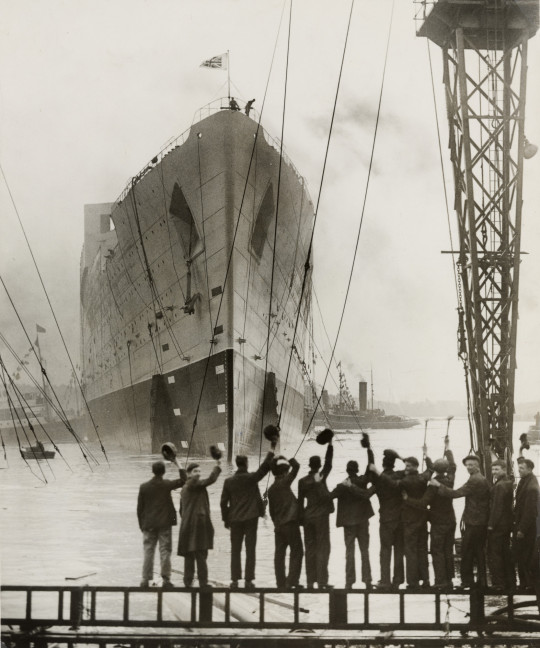

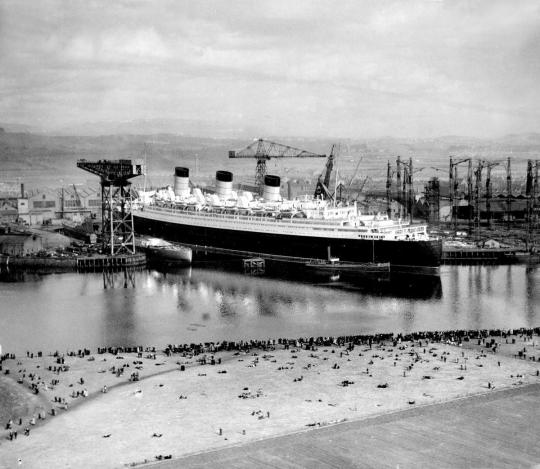
On September 26th 1934 the Liner Queen Mary launched at John Brown’s shipyard, Clydebank.
The construction of still the unnamed Cunard Queen Mary ship began in December 1930 (the ship’s keel was laid down on 31 January 1931) in the yard of “John Brown & Co” at Clydebank. The launch was scheduled for May 1932, but the work on the ship was suspended in December 1931 due to the world economic depression. A loan of 9.5 million pounds from the Government was granted to the Cunard Line with enough money to complete the Queen Mary ship and to build a second liner – the Queen Elizabeth.
As a direct result of this most advantageous deal, the Cunard Line merged with its main rival White Star on 10th May 1934 into Cunard White Star Ltd. The Queen Mary construction resumed in April 1934, the liner was completed by August and launched on 26th September at a total cost of 3.5 million pounds sterling.
The work was completed in March 1936. The Queen Mary ship sailed out for preliminary trials and after being painted in Southampton, the liner was handed over to Cunard White Star Line on 11th May 1936. RMS Queen Mary ship first sailing was on 14th May with its Transatlantic itinerary being Southampton-Cherbourg-New York. By May 1937 the liner had carried a total of almost 57,000 passengers.
The main speed-rival of the QM ship was SS Normandie – a liner built in France and operated by the French Compagnie Generale Transatlantique line. The Queen Mary took the Blue Riband (the prestigious award given to a ship with the speed record for a transatlantic crossing) from the French liner SS Normandie in August 1938, with record speeds for both west- and eastbound crossings of the Atlantic Ocean – the average speeds was, respectively, 30,63 kn (35m25 mph, 56,7 km/h) and 30,14 kn (34,68 mph, 55,82 km/h).
In 1937, the Normandie liner was refitted with new propellers, enabling her to take the Blue Riband, but in 1938 the Queen Mary ship reclaim the honour for best speeds in both directions – westbound 30,99 kn (35,66 mph, 57.39 km/h) and eastbound 31,69 kn (36,47 mph, 58.69 km/h). This record was beaten by the SS United Sates liner in 1952.
The last commercial sailing of the ship Queen Mary was on 30 August 1939 departing from Southampton and then berthed at New York until the end of 1939. With the outbreak of the Second World War, she was converted into a troopship and ferried Allied soldiers for the duration of the war.
Following the war, Queen Mary was refitted for passenger service and along with Queen Elizabeth commenced the two-ship transatlantic passenger service for which the two ships were initially built. The two ships dominated the transatlantic passenger transportation market until the dawn of the jet age in the late 1950s. By the mid-1960s, Queen Mary was ageing and, though still among the most popular transatlantic liners, was operating at a loss.
After several years of decreased profits for Cunard Line, Queen Mary was officially retired from service in 1967. She left Southampton for the last time on 31 October 1967 and sailed to the port of Long Beach, California, United States, where she remains permanently moored. Much of the machinery, including one of the two engine rooms, three of the four propellers, and all of the boilers, were removed. The ship serves as a tourist attraction featuring restaurants, a museum and a hotel. The ship is listed on the National Register of Historic Places. The National Trust for Historic Preservation has accepted the Queen Mary as part of the Historic Hotels of America.
RMS Queen Mary remains in Long Beach but recently it has been reported it is in need of significant repairs according to assessments and photos in 2019 and 2020. An estimated $289 million in repairs are needed after years of decline and the most recent operator going bankrupt.But even to “retire and recycle” the liner could cost up to $190m. One of the suggestions are to dismantle and sink the liner, although no long term plans have been finalised as yet.
The Queen Mary is due to open again to visitors next month, let’s hope someone can come up with a rescue plan to save her.
It has been mooted that it could return to the Clyde but the eyewatering amount of money it would take surely rules this out.
14 notes
·
View notes